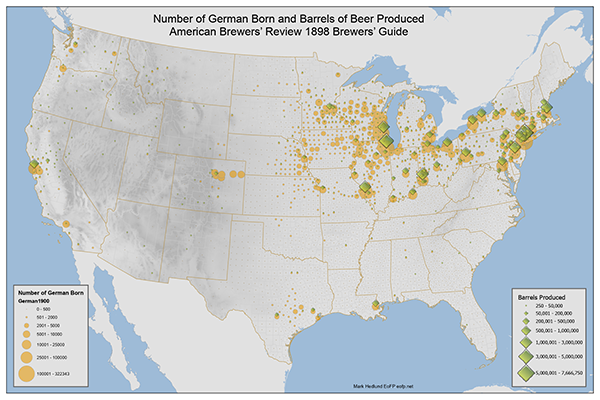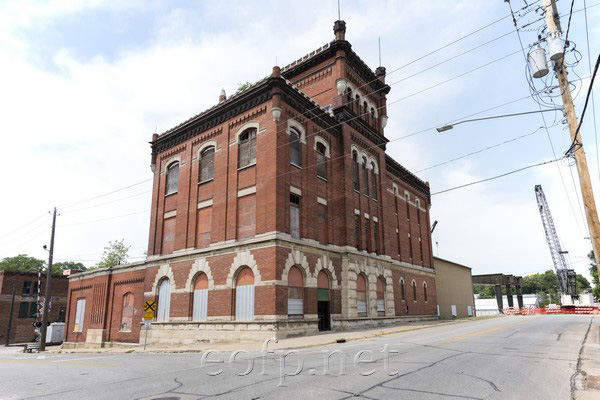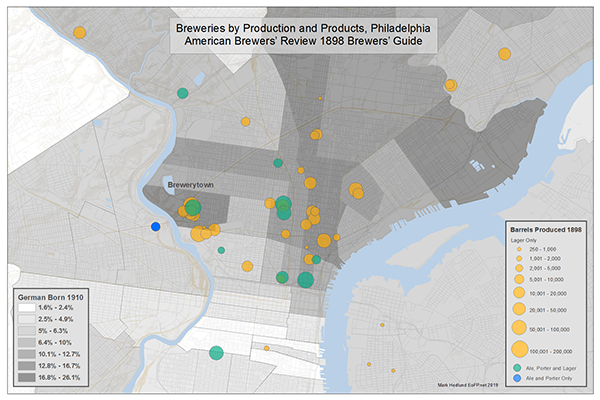Part 4: Germans in the Brewing Industry in 1898
This is the fourth of four articles that focus on the American Brewers' Review 1898 Brewers' Guide.
Introduction: American Brewers' Review 1898 Brewers' Guide
Part 1. An overview of the Brewers' Guide with production figures mapped
Part 2. A discussion of the types of beer brewed in 1898
Part 3. A brief discussion of bottling, malting, saloons and depots
Germans were by far the most significant ethnic group in the brewing industry in 1898. The 1900 Census counted 20,984 individuals with the occupation of “Brewer”. Of those, 15,825 reported that one or both of their parents had been born in Germany or 75%. That same census found just 9% of the general population had German born parents. The 1900 Census counted brewers with Austrian and Bohemian ancestry as well- only 252 and 224 respectively. The next largest ethnic group in the brewing industry after Germans were the 1,261 reported Irish brewers. The 1900 census of industry counted 47,105 people engaged in the brewing industry. The larger number includes those skilled tradesmen like pipe fitters that would have worked in breweries without being brewers. It also includes clerical and managerial workers and unskilled labor. I have no reason to think that the ethnic makeup of entire brewing companies would be significantly different from that of brewers.
Germans don’t have a genetic disposition to brewing beer. They did not possess knowledge of brewing that was unavailable to people of other ethnicities. Germans did not drink more beer than other Europeans like the British. Many Germans that wound up in the brewing industry in the US had no knowledge of brewing prior to immigration. For example, Eberhard Anheuser, the founder of Anheuser-Busch, manufactured soap in St. Louis before purchasing a brewery. Immigrant economic niches, like brewing for 19th Century German-Americans, usually develop around some initial advantage or necessity and then take on a life of their own. Cigar making was another economic niche for German-Americans but cigar making never developed as strong of a connection to German-ness in the American imagination. For whatever reason, brewing almost anywhere in the US, outside of the Northeast, was a German immigrant activity. This reality had developed since the Civil War and was firmly in place by 1898. The material culture of brewing in 1898 then, was largely an expression of German-American culture. The geography of the brewing industry though, was not the same as the geography of German-American immigrants.

Click for larger image.
The map above shows the percentage of German born by county in 1900 and the production of beer by county. There is some correspondence but in my opinion, the correspondence with industrial development is more pronounced.

Click for larger image.
The map above is similar to the one before but here German immigrants are symbolized by total number per county rather than percentage of population. This would be the same as the number of German beer drinkers, which many authors suggest was the foundation of the German brewer's business. The pre-prohibition brewery and its' extensions, where they exist today, are bits of material culture. The context in which that culture was produced is important. In many cases breweries were built in environments where German-ness was foreign or alien. In some of these situations the German-American cultural expression was emphasized through architecture and marketing. In other places German-ness was de-emphasized. In many urban locations however. like in German ethnic enclaves, the German cultural component of the brewing industry was endemic.
Moen Brewery in Burlington Iowa
Brewers used German and specifically Bavarian identity and cultural signifiers as marketing tools within their own communities and with non-Germans. Breweries were primarily functional structures but their ornamentation was often designed to express Bavarian identity. Images of breweries were used in advertisements and packaging. Some of this was probably earnest cultural expression while some was simply marketing. Some breweries that were isolated from large German populations did not seem to employ German motifs as much. The Schneider brewery in Trinidad Colorado, photo below, being one example. The promotion of German-ness eventually backfired on brewers when anti-German sentiment swept the country in WWI. But in the late 1800s, it was an evidently successful commercial strategy. Lager beer was promoted as a healthful alternative to distilled liquor. Wholesome images of German families enjoying beer together were employed to make this point. In spite of their shared interests, brewers and distillers did not work together. German brewers strove to disassociate themselves from images of alcohol abuse.
The first meetings of the United States Brewers’ Association were conducted in German. That organizations’ publications were published in both English and German until the 1890s. The United Brewery Workers Union, which became the main brewery workers union, also conducted its’ first meetings in German.
The Schneider brewery in Trinidad Colorado
Clusters of breweries developed in many larger cities. The relationships between clusters of breweries and German ethnic enclaves was not always straightforward. Smaller breweries in German neighborhoods in cities like Brooklyn and St. Louis often had attached beer gardens which accounted for significant shares of their business. Presumably, their customer base resided in the immediate neighborhood. Larger industrial breweries often did not sell beer on premises. The larger breweries shipped what they brewed to saloons throughout the city. Larger industrial breweries were established in locations that had commercial advantages other than being surrounded by potential customers. The cluster of breweries in Brewerytown Philadelphia developed near the Schuylkill River which was a source of natural ice in the winters. The main German population in the city, at that time, was in the neighborhoods immediately north and northeast of downtown. But after the breweries were built, Germans settled in the surrounding area and Brewerytown became an ethnic enclave. The largest breweries in New York City in 1898 had been built in uptown Manhattan a distance from any German ethnic enclave. Smaller breweries served the populations of German neighborhoods in Brooklyn. In Cincinnati, breweries were built in Over-the-Rhine embedded in a German ethnic enclave in the mid-19th century. By the end of the 1800s, those breweries still operated but the Over-the-Rhine neighborhood had become an ethnically mixed area.
Click for a larger image
All content on these pages Copyright Mark Hedlund 2012-2019. All rights reserved. Use in school projects and with links on social media is always okay. Please send me an email to request permission for any other use: hedlunch@yahoo.com Non-exclusive commercial publication rights for most photos is $25 per image.



